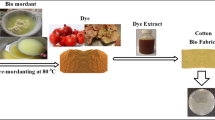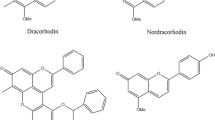Abstract
Natural dyeing of the textile substrate has been gaining interest in the last few decades if we consider environmental pollution and sustainability. Applying natural dyes with metallic or bio-mordant is entirely non-toxic, chemical-free, non-hazardous, and eco-friendly, in addition to the diverse functionalities attained by the fabric following the dyeing process. Banana midrib (Musa acuminata) is a natural product of anti-inflammatory, antibacterial, antiallergic, antioxidant, and anticancer properties used in pharmaceutical industries. It has brown-beige color and can be considered a natural dye. The novelty of this work is that banana midrib natural dye is applied on pineapple natural fabric. Because of the lack of affinity of this natural dye toward the textile substrate, this is applied with the help of babul bark as a bio-mordant over the pineapple. An interesting fact is that the color of babul bark is also brown-beige. Various concentrations of babul bark and banana midrib extract were used to dye the fabric. The fabric samples that underwent the dyeing process were tested for color coordinates, color strength, and fastness property determination while characterized for antibacterial, antioxidant, and ultraviolet protection. The color strength increased due to babul bark and banana midrib concentration. The dyed fabric has demonstrated exceptional properties in wash and rubbing fastness. The dyed fabric has shown 97.18% antibacterial activity, 99.87% antioxidant activity, and excellent ultraviolet protection. As a result, the successful dyeing of pineapple fabric using banana midrib natural dye and babul bark as a bio-mordant has been achieved. The dyeing process is both environmentally friendly and sustainable, imparting the fabric with multiple functionalities.
Graphical Abstract








Similar content being viewed by others
References
S. Adeel, F.U. Rehman, A. Hameed, N. Habib, S. Kiran, K.M. Zia, M. Zuber, Sustainable extraction and dyeing of microwave-treated silk fabric using arjun bark colorant. J. Nat. Fib. 17(5), 745–758 (2020). https://doi.org/10.1080/15440478.2018.1534182
O.K. Alebeid, L. Pei, A. Elhassan, W. Zhou, J. Wang, Cleaner dyeing and antibacterial activity of wool fabric using Henna dye modified with Acacia nilotica pods. Clean Technol. Environ. Policy 22, 2223–2230 (2020). https://doi.org/10.1007/s10098-020-01951-7
S. Ali, T. Hussain, R. Nawaz, Optimization of alkaline extraction of natural dye from Henna leaves and its dyeing on cotton by exhaust method. J. Clean. Prod. 17(1), 61–66 (2009). https://doi.org/10.1016/j.jclepro.2008.03.002
O. Avinc, A. Celik, G. Gedik, A. Yavas, Natural dye extraction from waste barks of Turkish red pine (Pinus brutia Ten.) timber and eco-friendly natural dyeing of various textile fibers. Fib. Polym. 14, 866–873 (2013). https://doi.org/10.1007/s12221-013-0866-0
J.A. Awomeso, A.M. Taiwo, A.M. Gbadebo, J.A. Adenowo, Studies on the pollution of water body by textile industry effluents in Lagos Nigeria. J. Appl. Sci. Environ. Sanit. 5(4), 353–359 (2010)
T. Bechtold, A. Turcanu, E. Ganglberger, S. Geissler, Natural dyes in modern textile dye houses—how to combine experiences of two centuries to meet the demands of the future. J. Clean. Prod. 11(5), 499–509 (2003). https://doi.org/10.1016/S0959-6526(02)00077-X
B.K. Behera, P.K. Hari, Woven textile structure: theory and applications (Woodhead Publishing Limited, New Delhi, 2010)
J. Cao, C. Meng, X. Cheng, X. Pan, Surface alkali deweighting and dyeing of polyester fabric by one-bath and one-step process. Surf. Innov. 7(2), 104–111 (2018). https://doi.org/10.1680/jsuin.18.00049
A. Davulcu, H. Benli, Y. Şen, M.İ Bahtiyari, Dyeing of cotton with thyme and pomegranate peel. Cellulose 21, 4671–4680 (2014). https://doi.org/10.1007/s10570-014-0427-8
S. Deshpande, D. Kadam, Phytochemical analysis and antibacterial activity of Acacia nilotica against Streptococcus mutans. Phytochem. Anal. 5(1), 236–238 (2013)
T.T. Falowo, I.P. Ejidike, L. Lajide, H.S. Clayton, Polyphenolic content of Musa acuminata and Musa paradisiaca bracts: chemical composition, antioxidant and antimicrobial potentials. Biomed. Pharm. J. 14(4), 1767–1780 (2021)
V.S.G. Garcia, T.L. de Freitas, J.M. Rosa, C.F. Suzuki, D.A. Roubicek, E. Nakano, S.I. Borrely, Multiple adverse effects of textile effluents and reactive Red 239 dye to aquatic organisms. Environ. Sci. Pollut. Res. 28, 63202–63214 (2021). https://doi.org/10.1007/s11356-021-15115-7
M.R. González, M.G. Lobo, M. González, Antioxidant activity in banana peel extracts: testing extraction conditions and related bioactive compounds. Food Chem. 119(3), 1030–1039 (2010). https://doi.org/10.1016/j.foodchem.2009.08.012
G. Gupta, M. Baranwal, S. Saxena, M.S. Reddy, Utilization of banana waste as a resource material for biofuels and other value-added products. Biomass Convers. Bioref.s (2022). https://doi.org/10.1007/s13399-022-02306-6
S. Haar, K. Saha, S. Patwary, T.D.T. Nguyen, S. Aryal, Measurement of aluminium and chemical oxygen demand in the effluent of mordanted cotton against environmental regulations. Clot. Text. Res. J. 39(3), 206–215 (2021). https://doi.org/10.1177/0887302X20939662
W. Haddar, N. Baaka, N. Meksi, I. Elksibi, M.F. Mhenni, Optimization of an ecofriendly dyeing process using the wastewater of the olive oil industry as natural dyes for acrylic fibres. J. Clean. Prod. 66, 546–554 (2014). https://doi.org/10.1016/j.jclepro.2013.11.017
O.E. Ismal, L. Yildirim, E. Ozdogan, Use of almond shell extracts plus biomordants as effective textile dye. J. Clean. Prod. 70, 61–67 (2014). https://doi.org/10.1016/j.jclepro.2014.01.055
P.R. Kumar, S. Srivastava, K.K. Singh, C. Mathad, P.S. Thin, Study of antioxidant and antimicrobial properties, phytochemical screening and analysis of sap extracted from banana (Musa acuminata) pseudostem. Int. J. Adv. Biotechnol. Res. 5(4), 649–658 (2014)
A. Kushwaha, K. Chaudhary, C. Prakash, A study on the mechanical properties of pineapple, bamboo, and cotton woven fabrics. Biomass Convers. Bioref. (2023). https://doi.org/10.1007/s13399-023-03841-6
A. Kushwaha, K. Chaudhary, C. Prakash, M.K.P. Naik, Selection of yarns for manufacturing handloom Varanasi brocade by using the AHP method. Polym. Bull. (2023). https://doi.org/10.1007/s00289-023-04970-8
A. Kushwaha, K. Chaudhary, S. Singh, C. Prakash, Application of ammonium polyphosphate as intumescent flame retardant on Varanasi brocade pineapple fabric. Biomass Convers. Bioref. (2023). https://doi.org/10.1007/s13399-023-04274-x
N.S. Mathew, P.S. Negi, Traditional uses, phytochemistry and pharmacology of wild banana (Musa acuminata Colla): a review. J ethnopharm 196, 124–140 (2017). https://doi.org/10.1016/j.jep.2016.12.009
W. Nuriana, M. Winarni, Utilization of sap from part of Kepok banana tree (Musa Mcuninata Balbisianacolla) with variation of extraction solutions as textile dyes. J. Phys. 1381, 12002 (2019). https://doi.org/10.1088/1742-6596/1381/1/012002
M.M. Rahman, T.M.A. Haque, N.S. Sourav, S. Rahman, S. Yesmin, R. Mia, K. Begum, Synthesis and investigation of dyeing properties of 8-hydroxyquinoline-based azo dyes. J. Iran. Chem. Soc. 18(4), 817–826 (2021). https://doi.org/10.1007/s13738-020-02070-2
N. Rajesh, Medicinal benefits of Musa paradisiaca (Banana). Int. J. Bio Res. 2(2), 5C1-54 (2017)
G. Richhariya, A. Kumar, P. Tekasakul, B. Gupta, Natural dyes for dye sensitized solar cell: a review. Renew. Sustain. Energy Rev. 69, 705–718 (2017). https://doi.org/10.1016/j.rser.2016.11.198
K.M. Sadeghi, S. Safapour, S.A. Habibzadeh, A.R. Tehrani-Bagha, Grafting of wool with alginate biopolymer/nano Ag as a clean antimicrobial and antioxidant agent: characterization and natural dyeing studies. J. Polym. Environ. 29, 2639–2649 (2021). https://doi.org/10.1007/s10924-021-02046-0
M. Shahid, F. Mohammad, Recent advancements in natural dye applications: a review. J. Clean. Prod. 53, 310–331 (2013). https://doi.org/10.1016/j.jclepro.2013.03.031
A. Sharma, S. Kadam, P. Mathur, J. Sheikh, Re-using henna natural dyeing wastewater for coloration and multifunctional finishing of linen fabric. Sustain. Chem. Pharm. 11, 17–22 (2019). https://doi.org/10.1016/j.scp.2018.12.001
A. Singh, J. Sheikh, Cleaner functional dyeing of wool using Kigelia Africana natural dye and Terminalia chebula bio-mordant. Sustain. Chem. Pharm. (2020). https://doi.org/10.1016/j.scp.2020.100286
G. Singh, P. Mathur, N. Singh, J. Sheikh, Functionalization of wool fabric using kapok flower and bio-mordant. Sustain. Chem. Pharm. 14, 100184 (2019). https://doi.org/10.1016/j.scp.2019.100184
Funding
Not applicable.
Author information
Authors and Affiliations
Contributions
The project was initiated, and AK undertook experiment design. AK and KC collaborated in designing the experiment for dyeing pineapple fabric with M. acuminata natural dye using A. nilotica as a bio-mordant. AK and SS were responsible for drafting the manuscript. AK, KC, and SS provided valuable input and feedback for the manuscript. All authors have reviewed and approved the final manuscript.
Corresponding author
Ethics declarations
Conflict of interest
The authors declare that they have no competing interests.
Consent for Publication
All authors agree to the publishing of the paper.
Additional information
Publisher's Note
Springer Nature remains neutral with regard to jurisdictional claims in published maps and institutional affiliations.
Rights and permissions
Springer Nature or its licensor (e.g. a society or other partner) holds exclusive rights to this article under a publishing agreement with the author(s) or other rightsholder(s); author self-archiving of the accepted manuscript version of this article is solely governed by the terms of such publishing agreement and applicable law.
About this article
Cite this article
Kushwaha, A., Singh, S. & Chaudhary, K. Cleaner Dyeing of Pineapple Fabric Using Musa acuminata Natural Dye and Acacia nilotica Bio-Mordant with Enhanced Functionality. J. Inst. Eng. India Ser. E (2024). https://doi.org/10.1007/s40034-023-00284-6
Received:
Accepted:
Published:
DOI: https://doi.org/10.1007/s40034-023-00284-6




